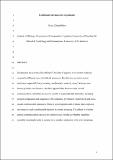Combinatorial capacities in primates
Abstract
Do primates have syntax-like abilities? One line of enquiry is to test how subjects respond to different types of artificial grammars. Results have revealed neural structures responsible for processing combinatorial content, shared between non-human primates and humans. Another approach has been to study natural communication, which has revealed a wealth of organisational principles, including merged compounds and sequences with stochastic, permutated, hierarchical and cross-modal combinatorial structure. There is solid experimental evidence that recipients can attend to such combinatorial features to extract meaning. The current debate is whether animal communication can also be compositional, that is, whether signallers assemble meaningful units to create utterances with novel meanings.
Citation
Zuberbuhler , K 2018 , ' Combinatorial capacities in primates ' , Current Opinion in Behavioral Sciences , vol. 21 , pp. 161-169 . https://doi.org/10.1016/j.cobeha.2018.03.015
Publication
Current Opinion in Behavioral Sciences
Status
Peer reviewed
ISSN
2352-1546Type
Journal item
Description
Funding: European Research Council (ERC grant GA 283871) and the Swiss National Science Foundation.Collections
Items in the St Andrews Research Repository are protected by copyright, with all rights reserved, unless otherwise indicated.

